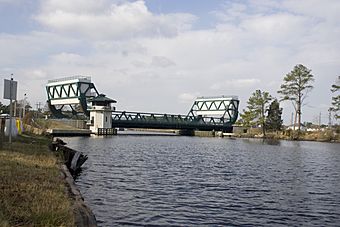Albemarle and Chesapeake Canal facts for kids
|
Albemarle and Chesapeake Canal Historic District
|
|

The Great Bridge over the Canal
|
|
| Location | Albemarle and Chesapeake Canal, Chesapeake (Independent city), Virginia |
|---|---|
| Area | 1,704 acres (690 ha) |
| Built | 1775 |
| NRHP reference No. | 04000035 |
Quick facts for kids Significant dates |
|
| Added to NRHP | February 11, 2004 |
The Albemarle and Chesapeake Canal is a historic waterway. It was built a long time ago to help boats travel easily. This canal connects the Chesapeake Bay in Virginia with the Albemarle Sound in North Carolina.
It was built by a company between 1856 and 1860. The canal made it possible for ships to travel safely inland. This meant they could avoid the rough waters of the open ocean.
Contents
What is the Albemarle and Chesapeake Canal?
The Albemarle and Chesapeake Canal is actually made of two separate canal sections. These sections are about 30 miles (50 km) apart. They work together to create a continuous water route.
The Virginia Section
One part of the canal is in Virginia. It is about 8.5 miles (13.7 km) long. This section connects the Elizabeth River with the North Landing River. Both of these rivers are important waterways in Virginia.
The North Carolina Section
The other part of the canal is in North Carolina. This section is about 5.5 miles (8.9 km) long. It links the Currituck Sound with the North River. These connections help boats move between different bodies of water.
Why Was the Canal Built?
Before canals, boats often had to travel on the open sea. This could be dangerous due to storms and rough waves. The Albemarle and Chesapeake Canal offered a safer way to travel. It created an "inland navigation" route. This means boats could stay inside the land, protected from the ocean.
The main goal was to make trade and travel easier. Goods could be moved more quickly and safely. This helped businesses and people in both Virginia and North Carolina.
A Historic Landmark
The Albemarle and Chesapeake Canal is very important historically. Because of its importance, it was added to the National Register of Historic Places in 2003. Being on this list means it is recognized as a significant part of American history.



